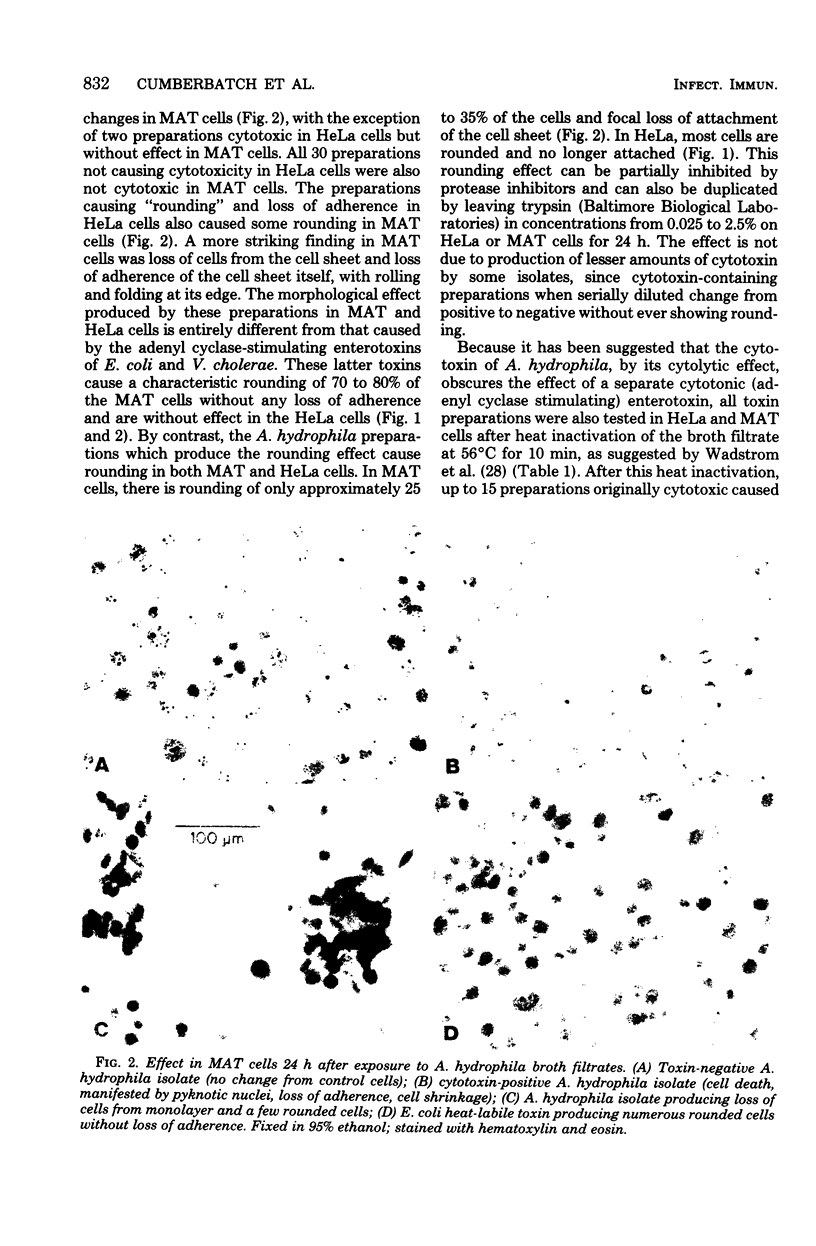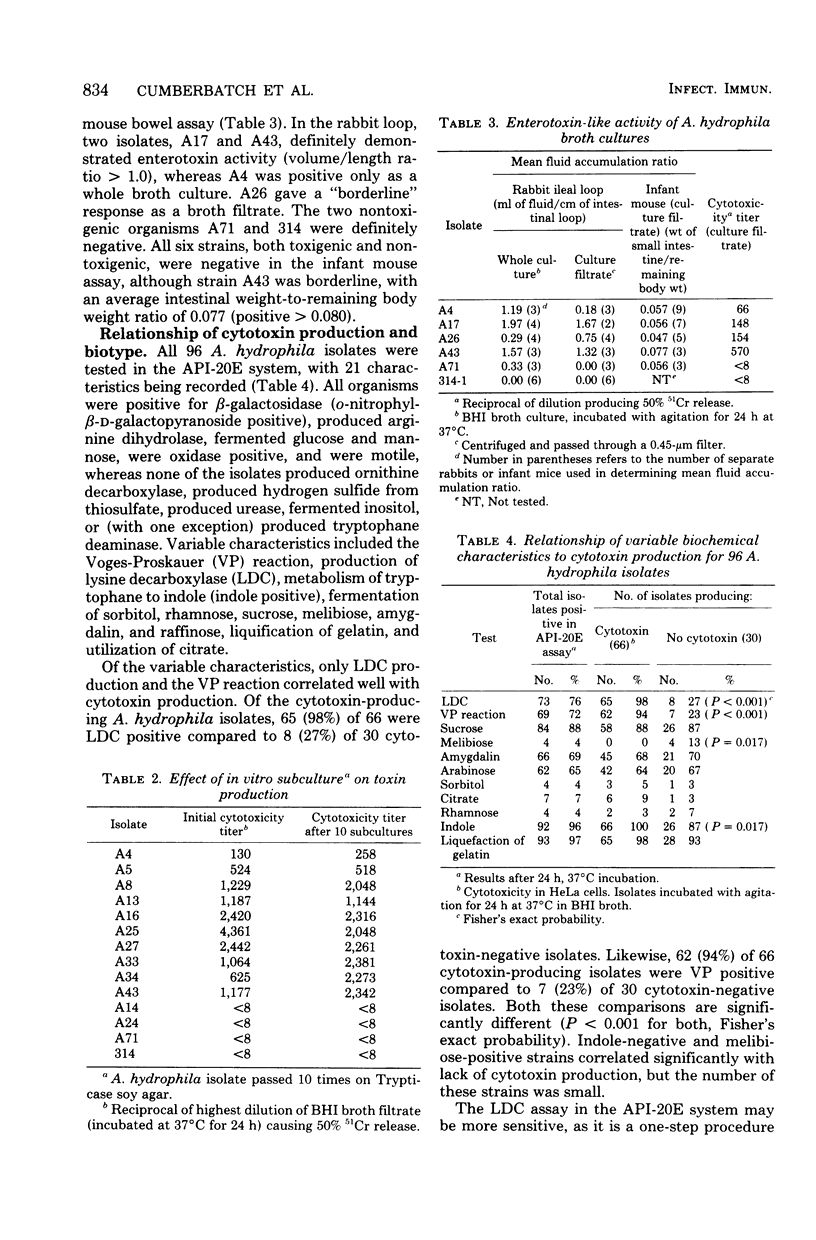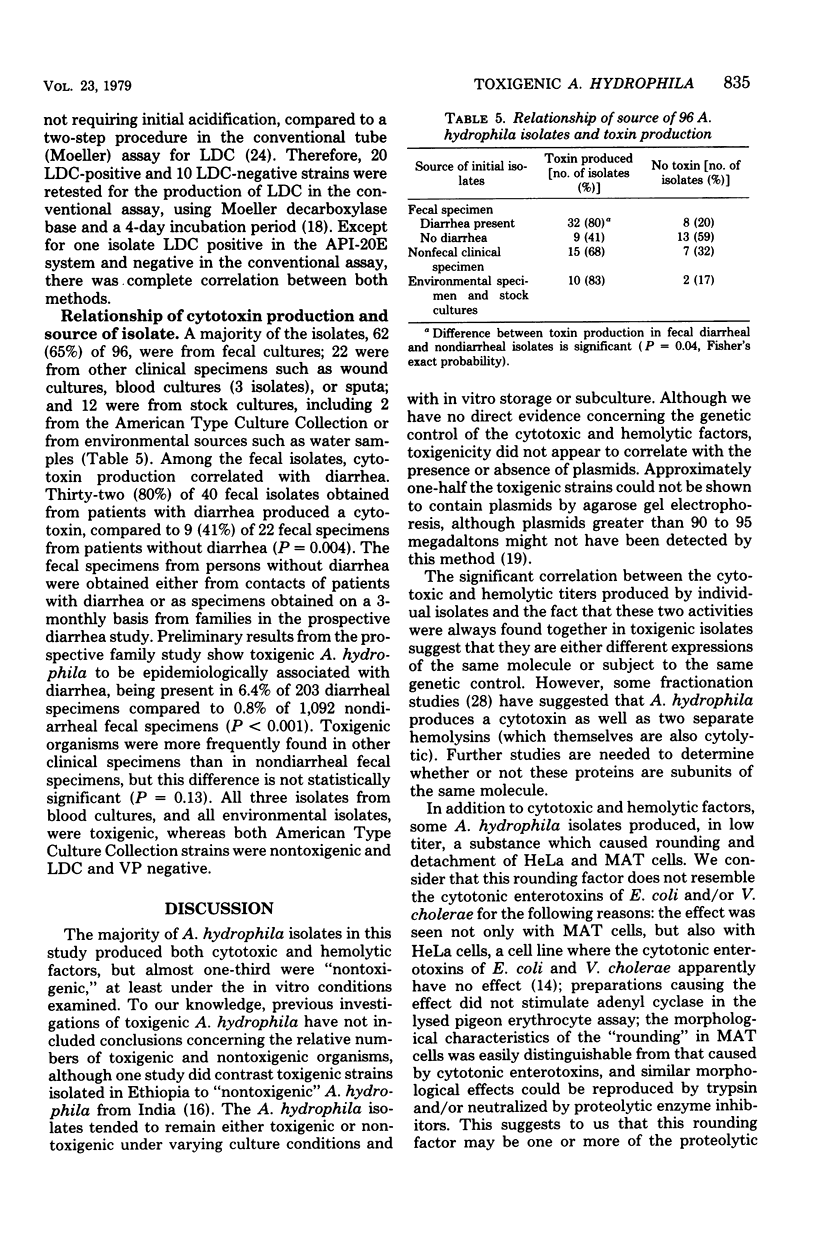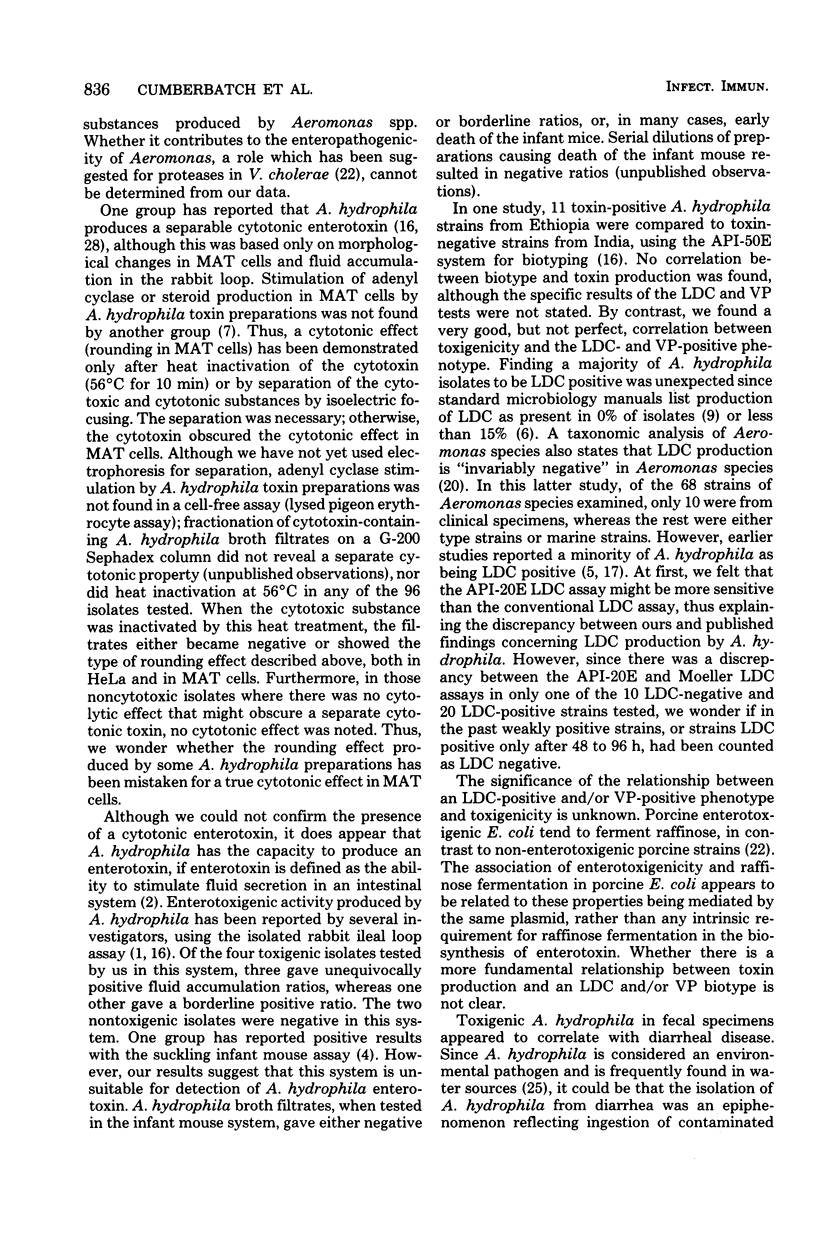Abstract
Ninety-six Aeromonas hydrophila isolates were tested for cytotoxin and hemolysin production. Sixty-six (69%) of the isolates were both cytotoxic and hemolytic, whereas the rest produced neither cytotoxin nor hemolysin. No evidence of a separate cytotonic activity could be found in any of the isolates. Cytotoxin activity correlated with enterotoxic activity. Of four cytotoxin-producing strains tested in the isolated rabbit ileal loop, three were definitely positive and one was borderline, whereas two nontoxigenic strains were negative. Cytotoxin activity appeared to be a stable property and could not be assoicated with any common identified plasmid; only 10 of 21 cytotoxin-producing strains could be shown to have any plasmid by agarose gel electrophoresis. Cytotoxin production correlated with a positive lysine decarboxylase phenotype (98%) or a positive Voges-Proskauer phenotype (94%), compared to 27% lysine decarboxylase-positive and 23% Voges-Proskauer-positive, cytotoxin-negative isolates (P less than 0.001 for both). In fecal samples, cytotoxin production correlated with diarrheal disease; of 40 diarrheal isolates, 32 (80%) were toxigenic compared to 9 (41%) of 22 nondiarrheal isolates (P = 0.004). It appears that A. hydrophila can be a cause of diarrhea and that this enteropathogenic potential is mediated by a cytotoxic enterotoxin.
Full text
PDF








Images in this article
Selected References
These references are in PubMed. This may not be the complete list of references from this article.
- Annapurna E., Sanyal S. C. Enterotoxicity of Aeromonas hydrophila. J Med Microbiol. 1977 Aug;10(3):317–323. doi: 10.1099/00222615-10-3-317. [DOI] [PubMed] [Google Scholar]
- Banwell J. G., Sherr H. Effect of bacterial enterotoxins on the gastrointestinal tract. Gastroenterology. 1973 Sep;65(3):467–497. [PubMed] [Google Scholar]
- Bernheimer A. W., Avigad L. S. Partial characterization of aerolysin, a lytic exotoxin from Aeromonas hydrophila. Infect Immun. 1974 Jun;9(6):1016–1021. doi: 10.1128/iai.9.6.1016-1021.1974. [DOI] [PMC free article] [PubMed] [Google Scholar]
- Boulanger Y., Lallier R., Cousineau G. Isolation of enterotoxigenic Aeromonas from fish. Can J Microbiol. 1977 Sep;23(9):1161–1164. doi: 10.1139/m77-174. [DOI] [PubMed] [Google Scholar]
- Chatterjee B. D., Neogy K. N. Studies on Aeromonas and Plesiomonas species isolated from cases of choleraic diarrhoea. Indian J Med Res. 1972 Apr;60(4):520–524. [PubMed] [Google Scholar]
- Donta S. T., Haddow A. D. Cytotoxic activity of Aeromonas hydrophila. Infect Immun. 1978 Sep;21(3):989–993. doi: 10.1128/iai.21.3.989-993.1978. [DOI] [PMC free article] [PubMed] [Google Scholar]
- Dowda H. Evaluation of two rapid methods for identification of commonly encountered nonfermenting or oxidase-positive, Gram-negative rods. J Clin Microbiol. 1977 Dec;6(6):605–609. doi: 10.1128/jcm.6.6.605-609.1977. [DOI] [PMC free article] [PubMed] [Google Scholar]
- Gilardi G. L. Morphological and biochemical characteristics of Aeromonas punctata (hydrophila, liquefaciens) isolated from human sources. Appl Microbiol. 1967 Mar;15(2):417–421. doi: 10.1128/am.15.2.417-421.1967. [DOI] [PMC free article] [PubMed] [Google Scholar]
- Gill D. M., King C. A. The mechanism of action of cholera toxin in pigeon erythrocyte lysates. J Biol Chem. 1975 Aug 25;250(16):6424–6432. [PubMed] [Google Scholar]
- Gurwith M. J., Williams T. W. Gastroenteritis in children: a two-year review in Manitoba. I. Etiology. J Infect Dis. 1977 Aug;136(2):239–247. doi: 10.1093/infdis/136.2.239. [DOI] [PMC free article] [PubMed] [Google Scholar]
- Gurwith M., Bourque C., Cameron E., Forrest G., Green M. Cholera-like diarrhea in Canada. Report of a case associated with enterotoxigenic Escherichia coli and a toxin-producing Aeromonas hydrophila. Arch Intern Med. 1977 Oct;137(10):1461–1464. doi: 10.1001/archinte.137.10.1461. [DOI] [PubMed] [Google Scholar]
- Keusch G. T., Donta S. T. Classification of enterotoxins on the basis of activity in cell culture. J Infect Dis. 1975 Jan;131(1):58–63. doi: 10.1093/infdis/131.1.58. [DOI] [PubMed] [Google Scholar]
- Ljungh A., Popoff M., Wadstrom T. Aeromonas hydrophila in acute diarrheal disease: detection of enterotoxin and biotyping of strains. J Clin Microbiol. 1977 Aug;6(2):96–100. doi: 10.1128/jcm.6.2.96-100.1977. [DOI] [PMC free article] [PubMed] [Google Scholar]
- McCracken A. W., Barkley R. Isolation of Aeromonas species from clinical sources. J Clin Pathol. 1972 Nov;25(11):970–975. doi: 10.1136/jcp.25.11.970. [DOI] [PMC free article] [PubMed] [Google Scholar]
- Meyers J. A., Sanchez D., Elwell L. P., Falkow S. Simple agarose gel electrophoretic method for the identification and characterization of plasmid deoxyribonucleic acid. J Bacteriol. 1976 Sep;127(3):1529–1537. doi: 10.1128/jb.127.3.1529-1537.1976. [DOI] [PMC free article] [PubMed] [Google Scholar]
- Popoff M., Véron M. A taxonomic study of the Aeromonas hydrophila-Aeromonas punctata group. J Gen Microbiol. 1976 May;94(1):11–22. doi: 10.1099/00221287-94-1-11. [DOI] [PubMed] [Google Scholar]
- Sack R. B., Hirschhorn N., Brownlee I., Cash R. A., Woodward W. E., Sack D. A. Enterotoxigenic Escherichia-coli-associated diarrheal disease in Apache children. N Engl J Med. 1975 May 15;292(20):1041–1045. doi: 10.1056/NEJM197505152922001. [DOI] [PubMed] [Google Scholar]
- Schneider D. R., Parker C. D. Isolation and characterization of protease-deficient mutants of vibrio cholerae. J Infect Dis. 1978 Aug;138(2):143–151. doi: 10.1093/infdis/138.2.143. [DOI] [PubMed] [Google Scholar]
- Smith H. W., Parsell Z. Transmissible substrate-utilizing ability in enterobacteria. J Gen Microbiol. 1975 Mar;87(1):129–140. doi: 10.1099/00221287-87-1-129. [DOI] [PubMed] [Google Scholar]
- Smith P. B., Tomfohrde K. M., Rhoden D. L., Balows A. API system: a multitube micromethod for identification of Enterobacteriaceae. Appl Microbiol. 1972 Sep;24(3):449–452. doi: 10.1128/am.24.3.449-452.1972. [DOI] [PMC free article] [PubMed] [Google Scholar]
- Von Graevenitz A., Mensch A. H. The genus aeromonas in human bacteriology report of 30 cases and review of the literature. N Engl J Med. 1968 Feb 1;278(5):245–249. doi: 10.1056/NEJM196802012780504. [DOI] [PubMed] [Google Scholar]
- Wadström T., Ljungh A., Wretlind B. Enterotoxin, haemolysin and cytotoxic protein in Aeromonas hydrophila from human infections. Acta Pathol Microbiol Scand B. 1976 Apr;84(2):112–114. doi: 10.1111/j.1699-0463.1976.tb01911.x. [DOI] [PubMed] [Google Scholar]
- Wadström T. Studies on extracellular proteins from Staphylococcus aureus. IV. Separation of alpha-toxin by isoelectric focusing. Biochim Biophys Acta. 1968 Oct 21;168(2):228–242. doi: 10.1016/0005-2795(68)90146-3. [DOI] [PubMed] [Google Scholar]
- von Graevenitz A., Zinterhofer L. The detection of Aeromonas hydrophila in stool specimens. Health Lab Sci. 1970 Jul;7(3):124–127. [PubMed] [Google Scholar]




